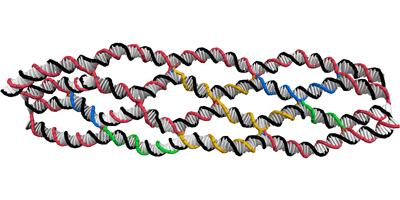The Blueprint for DNA Origami
DNA provides the code for life, but it also can be a construction material for self-forming nanostructures. So-called DNA origami takes advantage of the highly selective interactions between strands of DNA to make arbitrary two- and three-dimensional shapes. To help understand the potential of this nanotechnology, a group has generalized previous theoretical work that treats DNA as a “stack of plates.” The adapted model, described in Physical Review E, is able to reproduce mechanical and elastic properties of DNA origami.
Researchers know how to synthesize strands of DNA that self-organize into ribbons, boxes, and other forms that may eventually be used as electronic templates and nanorobots. After being heated and then slowly cooled, the strands fold and weave together, controlled by the unique pairings between DNA bases. However, current models of DNA origami tend to approximate these base pair interactions by using an effective elastic theory for the connections between strands.
Jean Michel Arbona and his colleagues from the Institute of Chemistry and Biology of Membranes and Nano-objects (CBMN) in Pessac, France, have devised a new coarse-grain model that specifically accounts for base pair interactions. They assume each base pair is like a rigid ellipsoid, or “plate,” that swivels and tips with respect to its neighbors. This model was originally developed for “normal” double-stranded DNA, but Arbona and collaborators are now applying it to the multiple strands that intertwine in DNA origami. In addition to base pair interactions, the model includes the electrostatic repulsion coming from excess charge on the DNA molecule. Using Monte Carlo simulations, the team searched for stable configurations, which ended up reproducing DNA origami structures that have been observed in experiments. – Michael Schirber





